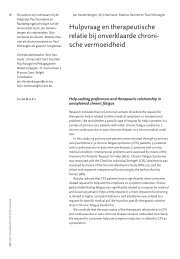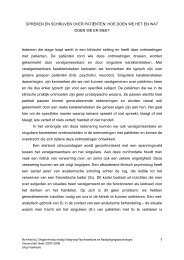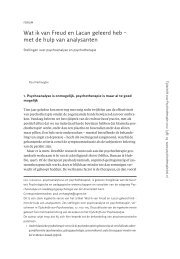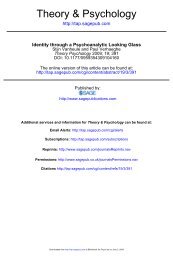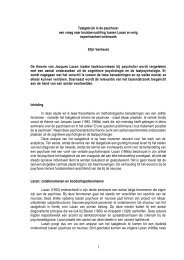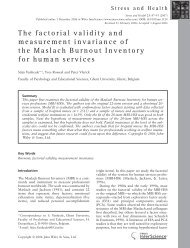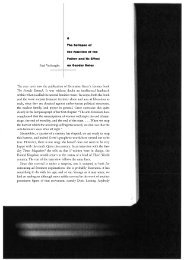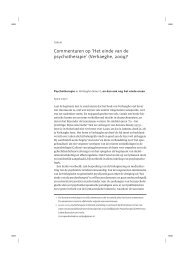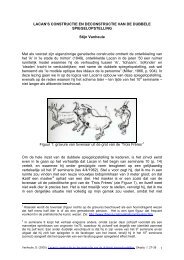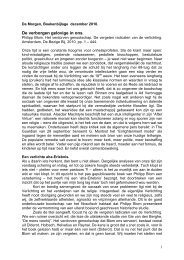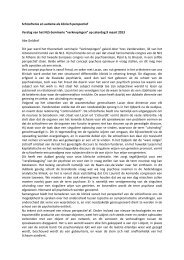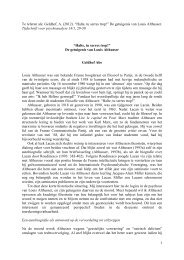psychotherapy and research
psychotherapy and research
psychotherapy and research
Create successful ePaper yourself
Turn your PDF publications into a flip-book with our unique Google optimized e-Paper software.
STIJN VANHEULE 101disorders, will be excluded from <strong>research</strong> samples. Since <strong>research</strong> indicatesthat co-morbidity is present in 50% to 90% of all <strong>psychotherapy</strong> patients(Ruscio & Holohan 2006; Westen, Novotny & Thompson-Brenner 2004),one could conclude that only 5% to 25% of the patients consulting for<strong>psychotherapy</strong>, are included in <strong>research</strong> on protocols. Even this estimation isoptimistic since it does not take into account the percentage of persons whorefuse to participate in <strong>research</strong>. Patients consenting to participate in RCTs<strong>and</strong> especially in efficacy studies are usually known to be highly motivated,which is not the case for the total reference population of <strong>psychotherapy</strong>patients (Richardson 2001; Tansella et al. 2006). As a consequence we canonly conclude that the samples used in RCTs tend not to be representativeof the actual population of persons that seek help from psychotherapists. Tothe extent that this is the case, it is methodologically objectionable to generalizeconclusions from RCTs to the population of <strong>psychotherapy</strong> patients.Yet this is what is currently done. Effectiveness studies starting from patientsamples that are representative for the reference population of patients areactually, in this respect, much more trustworthy (e.g. Bateman & Fonagy2008).A third assumption Westen, Novotny <strong>and</strong> Thompson-Brenner (2004) critiqueis that in RCTs psychological symptoms are typically understood <strong>and</strong>treated in isolation from personality dispositions, character traits or structuralviews on people’s mental organization. This idea is problematic sincebasic psychological science indicates that both are related – <strong>and</strong> in complexways (Luyten & Blatt 2007; Westen, Novotny & Thompson-Brenner 2004),<strong>and</strong> in clinical practice psychotherapists do take the broader context ofsomeone’s mental functioning into account. For example, imagine treating apatient who has only a major depressive disorder, as well as a patient with amajor depressive disorder <strong>and</strong> a clearly schizoid or psychotic way of relatingto the world. In practice, the presence of these schizoid or psychotic characteristicswill have a necessary impact on the approach to the depressiontreatment. However, in the theoretical model of the DSM these characteristicsare just considered as additive <strong>and</strong> not as interacting. Thankfully,studies indicating that personality does influence the outcome of RCTs <strong>and</strong>in fact interacts with the process of treatment are being published (e.g.Bagby et al. 2008; Blatt & Zuroff 2005; Luyten & Blatt 2007).A last assumption critically commented upon by Westen, Novotny <strong>and</strong>Thompson-Brenner (2004) concerns the ‘interest’ factor; the idea that protocolpsychotherapies – meaning st<strong>and</strong>ardized manualized therapies that fitthe RCT logic – are both interesting <strong>and</strong> promising ways of approaching<strong>psychotherapy</strong> (– see also Goldfried 2000; Goldfried & Eubanks-Carter2004). RCT <strong>psychotherapy</strong> is protocol <strong>psychotherapy</strong> that strictly adheres toa manual in which all steps of an intervention are prescribed in detail. Amanual of this type aims at removing all idiosyncratic influences of thetherapist providing the treatment; the only point of reference is nomothetic



